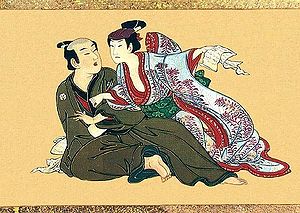
Jealousy sociology
Encyclopedia
 |
Anthropologists such as Margaret Mead have shown that jealousy varies across cultures. Cultural learning can influence the situations that trigger jealousy and the manner in which jealousy is expressed. Attitudes toward jealousy can also change within a culture over time. For example, attitudes toward jealousy changed substantially during the 1960s and 1970s in the United States. People in the United States adopted much more negative views about jealousy.
Causes of jealousy
Margaret MeadMargaret Mead
Margaret Mead was an American cultural anthropologist, who was frequently a featured writer and speaker in the mass media throughout the 1960s and 1970s....
reports a number of societies in which a man would offer his wife or daughter to others for sexual purposes, as well as cases in which "first wives" in polygamous
Polygamy
Polygamy is a marriage which includes more than two partners...
societies would welcome additional wives as enhancing their prestige and lightening their work. She contrasts the Dobuans, whose lives were dominated by jealous guardianship of everything from wives to yams, with the Samoa
Samoa
Samoa , officially the Independent State of Samoa, formerly known as Western Samoa is a country encompassing the western part of the Samoan Islands in the South Pacific Ocean. It became independent from New Zealand in 1962. The two main islands of Samoa are Upolu and one of the biggest islands in...
ns, among whom jealousy was rare.
It is possible that Mead's attribution of these differences to social arrangements is correct. Stearns
Peter Stearns
Peter N. Stearns is a professor at George Mason University, where he is provost with almost forty years of experience as a teacher and administrator. Stearns was Chair of the Department of History at Carnegie Mellon University and also served as the Dean of the Dietrich College of Humanities and...
similarly notes that the social history of jealousy among Americans shows a near absence of jealousy in the eighteenth century, when marriages were arranged by parents and close community supervision all but precluded extramarital affairs. As these social arrangements were gradually supplanted by the practice of dating several potential partners before marriage and by more fluid and anonymous living arrangements, jealousy as a social phenomenon correspondingly increased.
Others have questioned Mead's findings about Samoa.
Jealousy occurred far more frequently than Mead suggested and often resulted in violence. The Samoans have a word for such violence: fua. It may be that no society has the freedom from jealousy which Mead attributed to the Samoans. The incidence of jealousy may vary across cultures, but jealousy remains a cultural universal nonetheless.
Changes in attitudes
By the late 1960s and the 1970s, jealousy — particularly sexual jealousy — had come to be seen as both irrational and shameful in some quarters, particularly among advocates of free loveFree love
The term free love has been used to describe a social movement that rejects marriage, which is seen as a form of social bondage. The Free Love movement’s initial goal was to separate the state from sexual matters such as marriage, birth control, and adultery...
. Advocates and practitioners of non-exclusive sexual relationships, believing that they ought not to be jealous, sought to banish or deny jealous reactions to their partners' sexual involvement with others. Many found this unexpectedly difficult, though for others, conscious blocking of the jealous reaction is relatively easy from the start, and over time the reaction can be effectively extinguished. Some studies suggest that jealousy may be reduced in multilateral relationships where there is a clear hierarchy of relationships or where expectations are otherwise fixed. (See Smith and Smith, Beyond Monogamy.) Contemporary practitioners of what is now called polyamory
Polyamory
Polyamory is the practice, desire, or acceptance of having more than one intimate relationship at a time with the knowledge and consent of everyone involved....
(multiple intimate relationships) for the most part treat jealousy as an inevitable problem, best handled by accommodation and communication. In mainstream society, although jealousy still carries connotations of insecurity, there is a greater tendency to accept it as a normal and expected reaction to a relationship threat.
See also
- JealousyJealousyJealousy is a second emotion and typically refers to the negative thoughts and feelings of insecurity, fear, and anxiety over an anticipated loss of something that the person values, particularly in reference to a human connection. Jealousy often consists of a combination of presenting emotions...
- Jealousy definitions
- Jealousy in artJealousy in artJealousy in art deals with the way writers and graphic artists have approached the topic of jealousy in their works.Jealousy is the powerful complex of emotions experienced at the loss, real or imagined, of something or someone you believe is yours, whereas envy concerns what you don’t have and...
- Jealousy in religionJealousy in religionJealousy in religion examines how the scriptures and teachings of various religions deal with the topic of jealousy.Religions may be compared and contrasted on how they deal with two issues: concepts of divine jealousy, and rules about the provocation and expression of human jealousy.-Greek...
Related articles
- EmotionEmotionEmotion is a complex psychophysiological experience of an individual's state of mind as interacting with biochemical and environmental influences. In humans, emotion fundamentally involves "physiological arousal, expressive behaviors, and conscious experience." Emotion is associated with mood,...
- Attachment in adultsAttachment in adultsAttachment in adults deals with the theory of attachment in adult romantic relationships.Attachment theory was extended to adult romantic relationships in the late 1980s. Four styles of attachment have been identified in adults: secure, anxious–preoccupied, dismissive–avoidant, and fearful–avoidant...
- MonogamyMonogamyMonogamy /Gr. μονός+γάμος - one+marriage/ a form of marriage in which an individual has only one spouse at any one time. In current usage monogamy often refers to having one sexual partner irrespective of marriage or reproduction...
- Open marriageOpen marriageOpen marriage typically refers to a marriage in which the partners agree that each may engage in extramarital sexual relationships, without this being regarded as infidelity. There are many different styles of open marriage, with the partners having varying levels of input on their spouse's...
- Penis envyPenis envyPenis envy in Freudian psychoanalysis refers to the theorized reaction of a girl during her psychosexual development to the realization that she does not have a penis....

